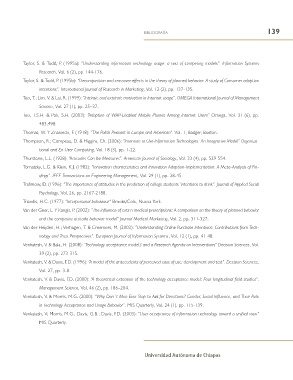Page 139 - LAS ACTITUD DE LOS ESPAÑOLES
P. 139
BIBLIOGRAFÍA 139
Taylor, S. & Todd, P. (1995a): “Understanding information technology usage: a test of competing models”. Information Systems
Research, Vol. 6 (2), pp. 144-176.
Taylor, S. & Todd, P. (1995b): “Decomposition and crossover effects in the theory of planned behavior: A study of Consumer adoption
intentions”. International Journal of Research in Marketing, Vol. 12 (2), pp. 137-135.
Teo, T.; Lim, V. & Lai, R. (1999): “Intrinsic and extrinsic motivation in Internet usage”. OMEGA International Journal of Management
Science, Vol. 27 (1), pp. 25–37.
Teo, T.S.H. & Pok, S.H. (2003): “Adoption of WAP-Enabled Mobile Phones Among Internet Users” Omega, Vol. 31 (6), pp.
483.498.
Thomas, W. Y Znaniecki, F. (1918): “The Polish Peasant in Europe and American”. Vol. 1, Badger, Boston.
Thompson, R.; Compeau, D. & Higgins, Ch. (2006): “Intention to Use Information Technologies: An Integrative Model” Organiza-
tional and En User Computing, Vol. 18 (3), pp. 1-22.
Thurstone, L.L. (1928): “Attitudes Can Be Measures”. American Journal of Sociology, Vol. 33 (4), pp. 529-554.
Tornatzky, L.G. & Klein, K.J. (1982): “Innovation characteristics and Innovation Adoption-Implementation: A Meta-Analysis of Fin-
dings”. IEEE Transactions on Engineering Management, Vol. 29 (1), pp. 28-45.
Trafimow, D. (1996): “The importance of attitudes in the prediction of college students ‘intentions to drink”. Journal of Applied Social
Psychology, Vol. 26, pp. 2167-2188.
Triandis, H.C. (1977): “Interpersonal behaviour” Brooks/Cole, Nueva York.
Van der Geer, L. Y Kangis, P. (2002): “The influence of cots n medical prescriptions: A comparison on the theory of planned behavior
and the composite attitude behavior model” Journal Medical Marketing, Vol. 2, pp. 311-327.
Van der Heijden, H.; Verhagen, T. & Creemers, M. (2003): “Understanding Online Purchase Intentions: Contributions from Tech-
nology and Trust Perspectives”. European Journal of Information Systems, Vol. 12 (1), pp. 41-48.
Venkatesh, V. & Bala, H. (2008): “Technology acceptance model3 and a Research Agenda on Interventions” Decision Sciences, Vol.
39 (2), pp. 273-315.
Venkatesh, V. & Davis, F.D. (1996): “A model of the antecedents of perceived ease of use: development and test”. Decision Sciences,
Vol. 27, pp. 3-8.
Venkatesh, V. & Davis, F.D. (2000): “A theoretical extension of the technology acceptance model: Four longitudinal field studies”.
Management Science, Vol. 46 (2), pp. 186–204.
Venkatesh, V. & Morris, M.G. (2000): “Why Don´t Men Ever Stop to Ask for Directions? Gender, Social Influence, and Their Role
in Technology Acceptance and Usage Behavior”. MIS Quarterly, Vol. 24 (1), pp. 115-139.
Venkatesh, V; Morris, M.G.; Davis, G.B.; Davis, F.D. (2003): “User acceptance of information technology toward a unified view”
MIS Quarterly.
Universidad Autónoma de Chiapas

